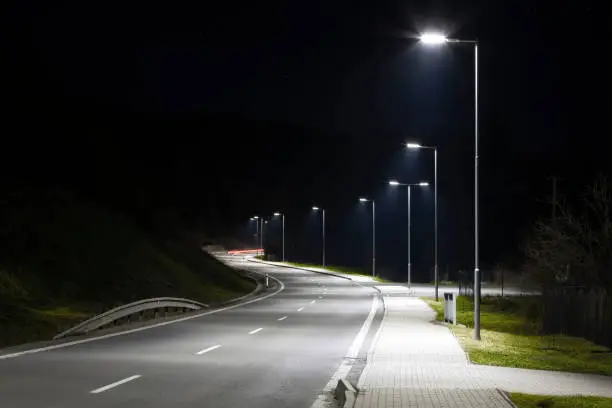Principles of Road Lighting Design To Ensure Safety & Visibility When Driving At Night
The road lighting design is a critical aspect of the construction of public works infrastructures such as urban roads because of the important set of public safety features such as: securing efficient driving and mitigating accidents, enhancing the public image of the city, minimizing criminal activities, etc. This insight emphasizes the need for a comprehensive handbook on urban road construction safety features which guides public works B2B companies, contractors, and city planners not only for regulatory needs but for effective service delivery.
Properly designed street lighting systems improve the visibility of roads for all types of road users, including motorists, pedestrians, and cyclists; decrease accident frequency; lower crime rate; and improve the attractiveness of the city. For every outskirts lighting business, staying ahead of cutthroat designer competition ensures large contracts on urban construction tenders by perfecting safety and efficiency design tactics.
The manufacturers, designers, and municipal corporators of street lights illuminating systems do adopt working aids that allow applying the design principles for safety at night that underscore step wise enhancements.
Concentrate on UniformityInstead of Intensity of Light
Visibility on roads is most often wrongly interpreted as directly linked to brightness. Increasing validity of a distance by raising lumen output would seem to be the solution for clarity, however, uneven brightness creates discomfort, glare and shadow zones.
The primary goal should be uniformity: a consistent distribution of light across the roadway and the adjacent pedestrian areas.
Other Important Factors Include:
- Spacing of the poles and fixtures: Correct spacing stops the possibility of overlapping hotspots or dark gaps.
- Mounting height and tilt angle: Affects the distance and level of evenness for the light cast.
- Beam shape and optics: Asymmetric lenses and cut-off optics aid in placing light where it is needed and nowhere else.
For most B2B professionals, particularly any outdoor light company , including features such as optimized optics, adjustable heads, and photometric planning assistance dramatically increases proposal competitiveness.
Adopting Road Class Based Design Strategies
Different roads serve different purposes and therefore have different lighting needs. The idea of road classification assists lighting engineers and designers in defining parameters for each type of roadway.
Common road classifications include:
- Highways and expressways. Require high mounting, long range optics, and strict glare control.
- Urban arterial roads. Need moderate brightness with high uniformity and consideration to ample pedestrians.
- Residential and collector roads. Focus on visual comfort and reduced energy consumption.
- Pedestrian zones and crossings. Require high vertical illumination and color rendering for detail, facial recognition, and clarity.
By aligning design with road classification, B2B project stakeholders can meet requirements of EN13201, IES RP-8, and other legislations on an international level while providing effective and safer results.
As an example, an innovative outdoor light company can create design manuals and offer photometric files appropriate to the road class to aid municipalities and consultants in planning.
Managing Glare, Contrast, and Comfortable Vision
Road lighting design should facilitate comfort while easing moral taxes versus fatigue, while providing a distraction free environment. Overwhelming glare leads to visual discomfort for drivers and pedestrians, and increases danger by obscuring and brightening objects.
To improve safety and reduce glare:
- Incorporate full cut-off or semi cut-off fixtures
- Employ luminaires with low UGR (Unified Glare Rating)
- Optimize pole Height-to-Spacing Ratio to reduce jump in Contrasting Light Levels.
- Account the highway surface reflectance as it can influence the perception of light.
High vertical illumination is very important for areas with a high density of pedestrians or cyclists. This assists people in recognizing objects at eye-level, like signs, other people, or potential hazards.
An outdoor light company with features such as anti-glare shields incorporated along with adaptable dimming and photometric tools, can provide municipalities with better solutions for safety and sustainability.
Merging Adaptive and Intelligent Lighting Systems
The forthcoming road and street lighting technologies rest in being flexible. Outdated, uniform-output lighting is set to give way as cities adopt intelligent systems that respond to real-time factors. Adaptive lighting systems are capable of dimming or brightening based on:
- Traffic flow
- Presence of people
- Weather conditions
- Time of day
These systems utilize sensors, cameras, and wireless control to alter lighting on the go, improving safety while energy conservation. For illustration, during low traffic periods, lighting can be reduced to 50% but will return to full brightness upon motion detection.
Adaptive systems present numerous benefits to B2B clients:
- Reduction in operating expenses due to decrease in energy use.
- Increased community satisfaction.
A competitive Outdoor Light Company should offer scalable smart lighting solutions for off-the-shelf IoT systems, from basic dimming activated by motion to fully integrated IoT-controlled systems. These not only align with smart city objectives but also provide sustainable revenues from maintenance and services over extended periods.
Environmental and climatic caring, maintenance, and longevity
B2B contract stakeholders that deal with long-term public infrastructure works understand that maintenance and durability together with the primary efficiency of the lighting system are core features which must be considered.
Critical factors to keep in mind are:
- Ingress Protection (IP) ratings regarding the resistance to water and dust * Corrosion-resistant materials within coastal or industrial areas
- High ambient temperature tolerance particularly in tropical regions
- Impact resistance, generally IK08, for vandal-prone areas
Apart from materials, Also considering ease of maintenance such as modular components, monitored drivers, and remote monitoring systems can lower costs and downtime. Tenders are not solely based on purchase price, but include models based on Total Cost of Ownership (TCO) regarding a 10 to 15 year period.
Consequently, any road lighting design project requires that an outdoor light company provides demonstrable lifecycle support for monitoring, upgrading, recycling or even end-of-life options needed beyond the first deployment.
Why Lighting Design Should Be a Strategic B2B Priority
Urban settings have advanced every day, but designers and urban planners face the challenge of ensuring compliance. Enhancing safety policies, and integrating energy-efficient technology are also essential. Investing in smart road lighting design is crucial, especially for lighting manufacturers and civil engineers.
Thoroughly executed road lighting not only instills a sense of public trust, but also underscores urban intelligence. In case of negligence, public safety and trust can be severely put at risk. This infrastructure acts as a connection between a city and its citizens.
Meeting the needs of B2B clients by adapting adjustable, flexible, and data-based light systems can automatically set a company apart in this field, advancing expectations instead of competition.
Conclusion
Today’s street lighting design goes beyond the installation of poles and fixtures, also considers the human elements of behavior as well as focuses on the precise blend of engineering optics. A strategic discipline integrating technology, The highlighted principles introduce cover uniformity, classification of roads, glare control, smart technologies as well as maintainability—all critical towards enhancing a sense of safety and visibility.
B2B partners have the upper hand in guiding modern cities that focus on these aspects of sustainability paired with advanced infrastructure. If you are an outdoor lighting company, urban planner, contractor, or a designer focusing on these fundamentals of road lighting design guarantees sustained competitiveness in the evolving infrastructure market.











